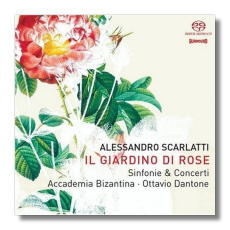
The Internet's Premier Classical Music Source
Related Links
- A. Scarlatti Reviews
- Latest Reviews
- More Reviews
-
By Composer
-
Collections
DVD & Blu-ray
Books
Concert Reviews
Articles/Interviews
Software
Audio
Search Amazon
Recommended Links
Site News
 SACD Review
SACD Review
Alessandro Scarlatti

Il Giardino di Rose
- 6 Harpsichord Concertos
- Sinfonias:
- Agar et Ismaele esiliati
- Il primo omocidio
- L'Assunzione della Beata Vergine
- Il trionfo della Vergine assunta in Cielo
- Il giardino di rose
- San Filippo Neri - Introduttione
Ottavio Dantone, harpsichord
Accademia Bizantina/Ottavio Dantone
Decca 470650-2 DDD 75:13 Hybrid SACD
The music on this CD is divided between material definitively composed by Alessandro Scarlatti (1660-1725) and material only possibly composed by him – namely, the six harpsichord concertos. For years, it was theorized by many musicologists that these latter works are not by the composer, in spite of the fact that the manuscript (located in the British Library in London) bears the composer's name. The primary reasons are as follows: the manuscripts are not in his hand, and the music is a stylistic hybrid. Furthermore, why would the only copy of important music by an Italian composer be extant only in England?
Nevertheless, musicologist Alessandro Borin, the man who reconstructed these works from the often sketchy English manuscripts, argues that it is entirely possible that Scarlatti was the composer after all. The reasons are too detailed to go into here, but suffice it to say that apparently England enjoyed a so-called "Scarlatti cult" dating back to the early 1700s. Although it was Domenico Scarlatti, Alessandro's son, who attracted the most attention during this period, it appears that his father's works were held in esteem during this period too. In effect, what we have here is a mystery story, but I suppose that few people really care "whodunit" as long as the music itself is pleasant and interesting… which it is.
These two-movement concertos resemble each other in that the first movement is a fairly conventional, even old-fashioned fugue, and the second movement is more modern – the fugue's "chaser," if you will. Whether Scarlatti wrote these concertos or not, they represent another step toward the establishment of the harpsichord as a viable solo instrument, and not just part of the continuo. Lacking the brilliance and verve of Vivaldi and the melodic appeal of Albinoni, these works are charming nevertheless, and Borin's light-textured reconstructions are viable.
To give the program variety, Dantone has interspersed the concertos with several sinfonias from Scarlatti's oratorios. The sinfonia, a type of overture, does not necessarily represent the subject of the oratorio. There is no "murderous" music to depict Cain, the "first murderer," for example. That is because, as was customary for the time, sinfonias could be recycled from works already in existence, or interchanged from one oratorio or opera to another.
The strings-only Accademia Bizantina is one of those "next generation" authentic instruments ensembles in which attractive tone is no less of a priority than it is in ensembles that play more modern music. There are six violins, one viola, two cellos, one "violoncello piccolo," and one violone. The continuo is completed by either the harpsichord (played by director Ottavio Dantone) or by chamber organ.
Appropriately, this recording was made in the Casa Romei in Ferrara, Italy.
Copyright © 2004, Raymond Tuttle


















